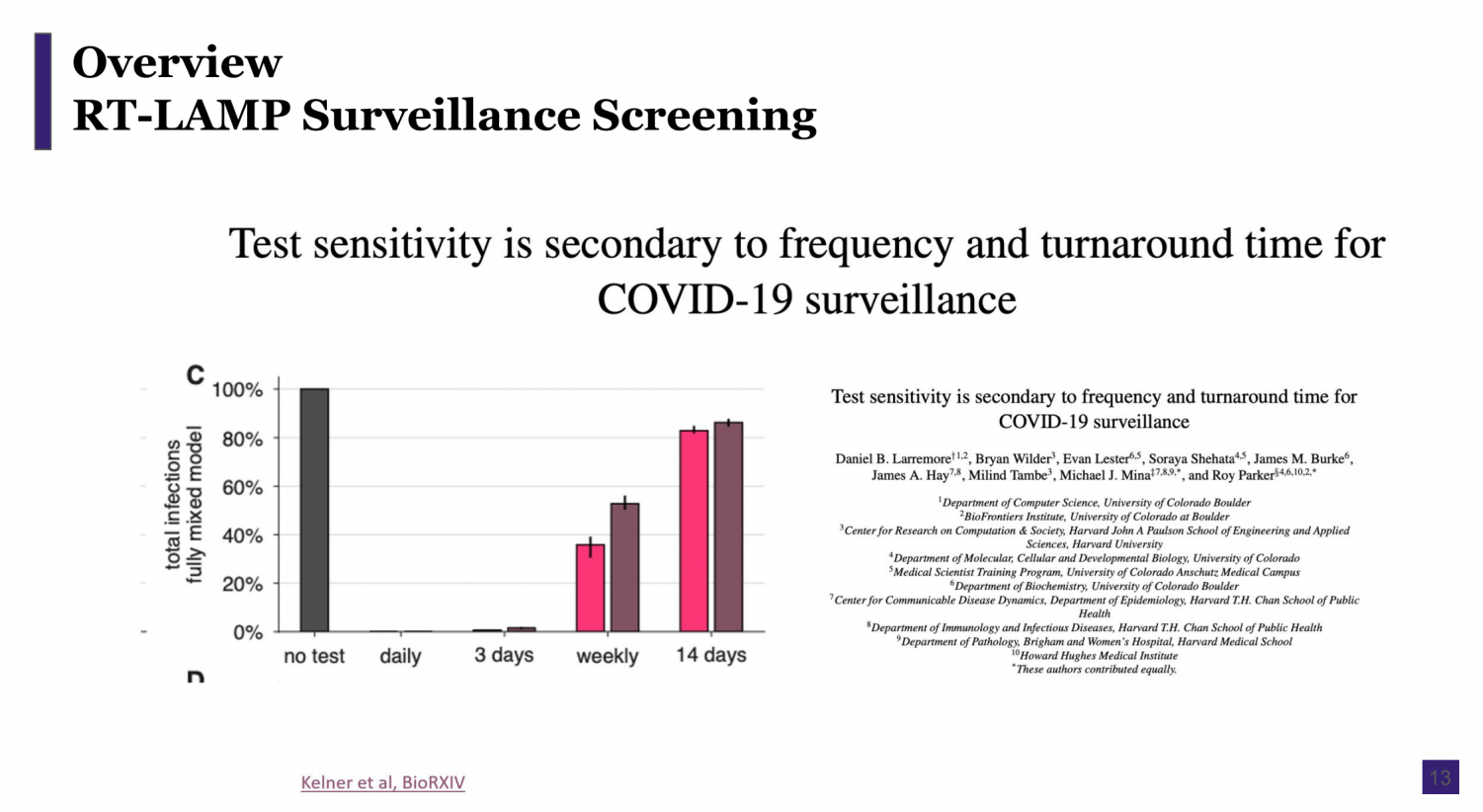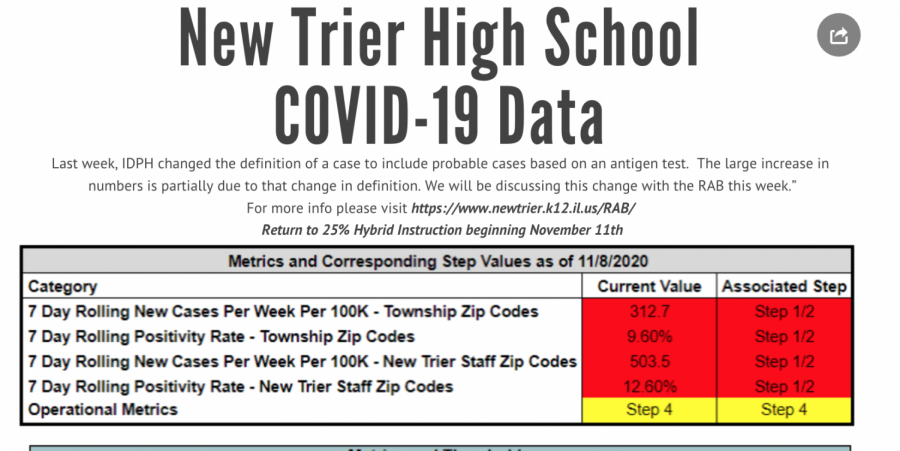The Staff Are Not Alright: Why New Trier Must Not Reopen
The saliva-based testing is not a silver bullet
According to New Trier’s own website, our community-based COVID metrics indicate that we should be in step 1/2 | newtrier.k12.il.us.
I miss the nurses’ office (or “Health Services” as we call it) quite a bit. When we were back in school, I could always count on the nurses to treat me with care and affection during my visits, which were quite frequent due to my chronic illness. This nostalgia, I think, is what made listening to the fears of Health Services’ department assistant, Helen Oushana, at the Board of Education meeting on Nov 4 so painful. The meeting was called to discuss whether we should re-open; Oushana spoke against it.
As a member of the New Trier support staff, Oushana has been at the Winnetka campus every day that New Trier has been open. She doesn’t have the option to opt-out of in-person school, as students do; instead, she could request accommodations for remote employment. However, several requests for accommodations were denied by the school, reported the Chicago Tribune.
Additionally, Oushana told me that the accommodations themselves were unfeasible for some. “As support staff, we do have the option to request accommodations, however, because these accommodations come directly from the U.S. Dept of Labor (Family First Coronavirus Response Act) many of us cannot afford to take the time at 2/3rds the rate of pay,” she wrote to me in an email.
So, when the Board of Education votes to reopen or not, the people most directly affected by it are the support staff and the teachers. It would thus make sense that the staff was well-represented in the Reopening Advisory Board, the group of individuals who decided on what the safe metrics were to re-open.
However, those decided upon metrics were thrown out the window last Wednesday when the Board of Education voted to move to Step 4, despite test-positivity rates and numbers of cases indicating that we should be in Step 2.
“What is equitable about this situation?” asked Oushana, her voice slightly trembling. “I work at a health office and am a single mother of four children: I am the caretaker and the breadwinner. If I get sick, who takes care of my children? I don’t have the luxury of not coming to work — I can’t afford that. So while some people may be fortunate enough to do this, I am in a position to sacrifice either my livelihood or my family.”
Oushana has to make this sacrifice because the Board of Education believes that the voluntary saliva screening program is the most precise metric, which somehow means that it’s the only important metric. The saliva screening has not supplemented the community COVID metrics, it has replaced it. They don’t say that with words, but the graph is clear; 4 metrics indicating we should be in Step 1 or 2 are outweighed by the vague “Operational Metric,” which likely is an arbitrary-set metric factoring in PPE, social distancing etc. and the saliva tests.
Since things like PPE or social distancing are stagnant, i.e they will be at the same level regardless of COVID spread, the only factor that determines what level this all-powerful Operational Metric is set at, and thus, if the school re-opens, are these tests.
So, let’s take a look at the test, which is the RT-Lamp saliva test. According to Carol Duccomon, a board member who spoke favorably about the saliva test, the test picks up about “85-90%” of cases that the Polymerase chain reaction (PCR) test, the gold standard of COVID tests, detects. While this number might not seem low, it means that out of every 10 students with COVID, 1-2 will not be detected by these tests. Duccomon admits that this sensitivity rate is relatively low, however, she argues that the PCR test could be too sensitive and detect a high rate of individuals with relatively low viral loads. While she’s correct that the PCR test doesn’t make a distinction between high and low viral loads, it’s categorically better to detect a small amount of virus and quarantine than to not detect infectious virus — and 10-15% of these saliva tests will have false negatives.
Another argument about the saliva tests forwarded by the Board of Education is that the frequency of the test is more important than the sensitivity, ie a less sensitive test that is done frequently is more effective than a sensitive test done less frequently. The study that is cited in the COVID-19 Screening Program slideshow indeed indicates that when participants were tested daily or every three days, the infection rate was strongly mitigated. However, the majority of New Trier students will only be testing on a bi-weekly basis, given that they are only going to school on a biweekly basis. The study states that the participants who tested on a biweekly basis only had about 20% of infection mitigation, compared to around 50% weekly and almost 100% daily. This minute mitigation from the frequency is likely not effective enough to overcome the relatively low sensitivity of the RT-Lamp saliva tests.

Additionally, the test is optional for students and staff, which means that if a small percentage of the school population actually completes the picking up/dropping off of the saliva, the number of people in the building who may have it increases. At the Board meeting, they stated that 95% of hybrid students opted into the program, and about 70% of teachers, which is a good sign. However, it will be interesting to see if those same numbers are reflected in terms of people actually going through with the test.
Of course, testing is always better than not testing, and the saliva tests will provide another layer of safety to the school building. The low sensitivity rate of these tests could be forgiven if they were supplemental tools to our metrics for re-opening.
However, these tests have become the only standard for whether students come to school or not, which means the Board and the school community writ large has to be confident that these tests will be extremely effective and weigh the costs and benefits fairly. Yet, at last Wednesday’s Board meeting, neither Superintendent Paul Sally nor any Board members raised any concerns about the program. Indeed, it almost seemed as if they were advertising the testing program; providing only evidence in favor and no evidence against. But there are clear doubts as to the effectiveness of these tests, and there is more nuance to the rosy picture they painted of the success of the program.
The only reasoning given by the Board of Education to ignore the community-based metrics is that the Saliva screening assesses specifically what is in the building — but if there’s a risk that the tests aren’t accurate, we still need to take into account COVID metrics. As of Nov. 8 the 7-day rolling positivity rate for New Trier Township is about 9.6%, and the 7-day rolling positivity rate for staff zip codes is 12.6%, more than twice the 5% threshold to move to Step 2. Our own metrics are telling us, with fire-hydrant-red markers, not to re-open. Yet, despite the fears of staff and teachers, we are rushing forward.
This steady rise of cases has led other suburban high schools of New Trier’s size such as Evanston Township, Oak Park-River Forest, Naperville Central, and Niles North to delay reopening. Yet, Sally is proud that New Trier is one of the only schools of our size to create a hybrid plan — he called it a sign of our school’s “innovation.” If staff members are coming to Board meetings in tears, if information is presented in a slanted manner, if there is vague language around what community metrics will be utilized for, you can be sure it isn’t innovation. It’s an unnecessary, hubristic risk.







































